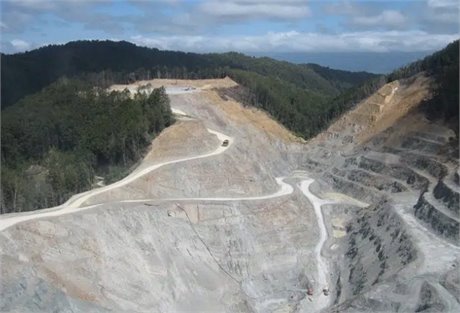 |
| Reefton Mine |
By Jeremy Rose
Australian mining company Santana Minerals estimates there’s 82 tonnes of gold in its Rise and Shine site in the central Otago hills.
Extracting that gold, worth billions of dollars, will involve digging up millions of tonnes of ore and then leaching it with cyanide.
Assuming all 82 tonnes (2.9 mllion ounces) of the estimated gold at the site is recovered about 73 tonnes of it will end up in either bank vaults or as jewellery.
Santana describes it as the biggest gold discovery in 40 years and says it plans to have resources consents submitted by the end of the year.
When asked about the mining proposal announced earlier this month, minister of resources Shane Jones told RNZ that New Zealand was at a crossroads in terms of climate change policy.
“Mining is absolutely essential for a credible climate change response in terms of rare earth minerals – absolutely necessary for decarbonisation,” he said.
And he promised to introduce fast-track consenting legislation to allow projects like the Santana’s 272 sq km Bendigo-Ophir site proposal near Tarras.
Gold may be among the rarest of elements but there’s no shortage. The World Gold Council estimates there’s currently about 190,040 tonnes of gold in the world.
When it comes to climate change gold mines are part of the problem not the solution: Global greenhouse gas (GHG) emissions from gold mining exceed 100 Mt CO2-e annually – about the same amount as 27 coal powered power plants.
Cambridge University academic and climate policy expert Stephen Lezak says only about 8% of mined gold ends up being used for industrial purposes – mainly cellphones and dentistry.
The case for leaving gold in the ground, Lezak says, is even stronger than that for coal and investor and shareholder pressure has seen the likes of BHP and Rio Tinto divesting from the latter.
And in practical, if not financial, terms ending the mining of gold is a far simpler task. Already about a fifth of the gold used is industrial processes is met by recycling.
Lezak says the recycling of e-waste could be ramped up to meet the rest of the demand without having to dip into the tens of thousands of tonnes of gold currently languishing in bank vaults.
“Unlike copper, for example, the world can easily do without more gold,” he says.
“When you take an objective look at the social and environmental costs and you weigh those against the benefits of extraction it doesn’t make sense.
“Living in the 21st Century is about making tough choices. The thing about gold is there are so many good substitutes available. If you want something beautiful there are other things besides gold that are beautiful, if you want to wait a store wealth, there are other ways to store wealth.”
He says gold is valuable in spite of new production, not because of it, and if the supply of new gold was to dry up that would simply see the price of gold increase.
“It is true that the global economy relies in part upon gold—but that is not the same as relying upon mining.”
Lezak is far from alone in calling for an end to coal mining. In 2017, following a decade of protest, El Salvador passed the world’s first and only blanket ban on metal mining.
And investor Warren Buffett sold off his gold holding in 2021 saying: “Gold gets dug out of the ground in Africa, or someplace. Then we melt it down, dig another hole, bury it again and pay people to stand around guarding it. It has no utility. Anyone watching from Mars would be scratching their head.”
Time to put an end to gold mining in Aotearoa: Coromandal Watchdog of Hauraki
Coromandel Watchdog of Hauraki chair Catherine Delahunty agrees that it’s time to end gold mining for good.
“We have large quantities of gold above the ground already which can be re-used for technology, and the development of “urban mining” of e-waste is the future source of gold and other minerals.
“The real cost of mining is in fossil fuel use, toxic waste dump legacies and risks to water and forests,” she says
Delahunty says the Santana website claims the Bendigo-Ophir project will bring prosperity to the region but in reality it will enrich the company at a huge and ongoing cost to the environment.
She says the government seems to have forgotten how much public support there is for the protection of mountains and forests. “Forty thousand people marched against mining conservation land in 2010.”
Monetising it in the ground
University of Western Australia professor of finance Dirk Baur proposed in a 2021 paper, Green Gold, that the precious metal be left in the ground with nature acting as a “natural vault”.
Exploration companies would still prospect for gold but instead of digging it up at huge environmental and social costs the reserves would be tokenised and sold in a similar way to crypto currencies.
Carbon News emailed Santana Minerals for comment but is yet to hear back.
- SEO Powered Content & PR Distribution. Get Amplified Today.
- PlatoData.Network Vertical Generative Ai. Empower Yourself. Access Here.
- PlatoAiStream. Web3 Intelligence. Knowledge Amplified. Access Here.
- PlatoESG. Carbon, CleanTech, Energy, Environment, Solar, Waste Management. Access Here.
- PlatoHealth. Biotech and Clinical Trials Intelligence. Access Here.
- Source: https://www.carbonnews.co.nz/story.asp?storyID=29642



